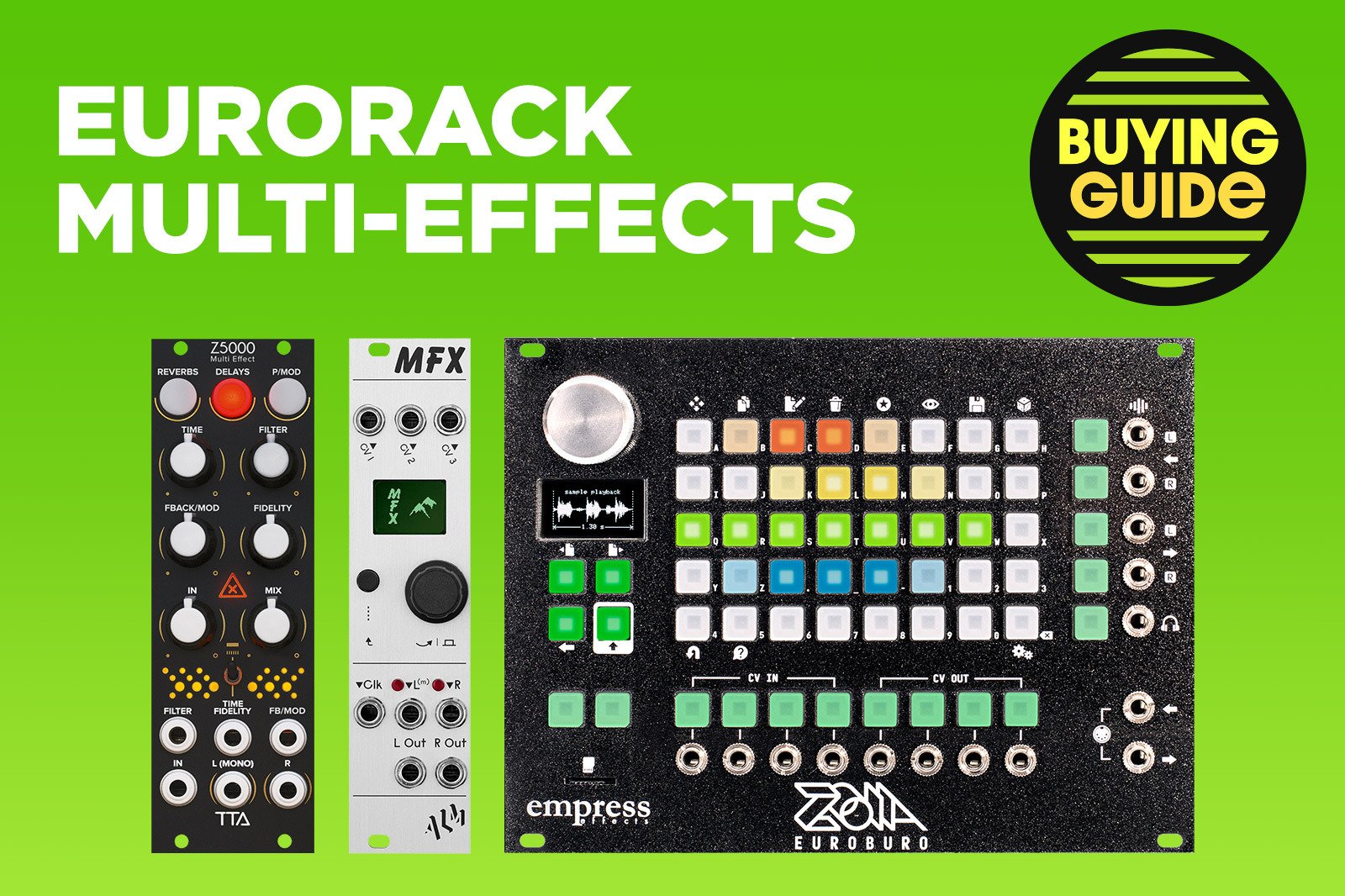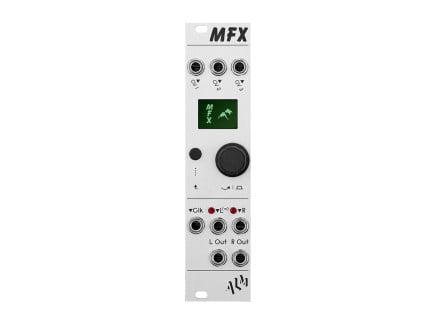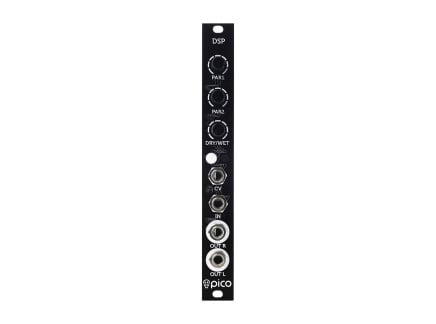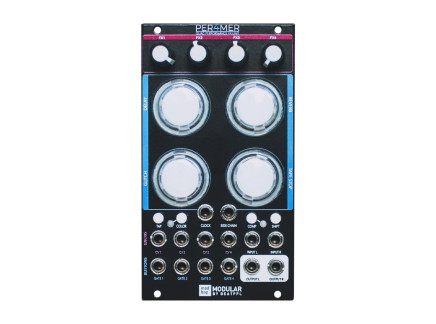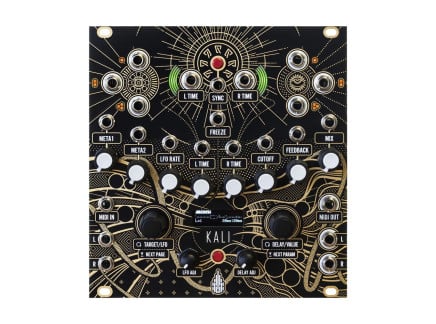Eurorack multi-effect modules can transform simple systems into versatile powerhouses. You can create ethereal reverbs, strange, ever-lasting delays, spectral shimmers, and so much more—all with just one module. In this buying guide, we have compiled a list of some of our favorite multi-effects modules for Eurorack.
In this list, there is something for everyone—feature-rich, menu-diving monsters, straightforward multi-effects goodness, and configurable units that let you go modular within modular. Let’s dive in!
ALM MFX
At just 6HP, ALM Busy Circuits MFX has a very high functionality-to-HP ratio. It is a stereo effects processor with 16 built-in effects programs, one of which can be active at any given time.
Half of these effects are in the stereo-imaging and space-shaping territory. You have various echoes, reverbs, and tape delays to build ethereal or haunting atmospheres. The other half is dedicated to transient shaping and dynamics processing. So, you have gnarly distortion programs, compressors, glitchy effects, and even granular capabilities. MFX even has a bit corrupter for those audience-pleasing corrupt audio tricks.
You can modulate the various parameters of the different effects via the 3 assignable CV inputs. There is also a clock-in for syncing your delays (or other effects) to an external clock. Navigating the MFX is easy. There is a push encoder for navigating the various menus and sub-menus, and a handy back button, too. There are factory presets for each program so you can start playing right out of the box. And you can store your own presets and recall them quickly using the main menu.
MFX is also compatible with the Axon-1 and Axon-2 expanders, great for adding more assignable CVs and hands-on controls for its internal parameters.
Key Features:
- Stereo I/O
- 16 effects programs
- 3 assignable CV inputs
- Clock-sync
- Oscilloscope and tuner
- USB C for firmware updates
- Push encoder for easy navigation
Xaoc Devices Timiszoara
Timiszoara is a 10HP multi-effects module based on the 24-bit Spin FV1 chip—a common chip used in the world of Eurorack and pedal-format effect processors. But don't let that fool you—Xaoc designed all of Timiszoara's effect algorithms from the ground up, getting surprising sound quality and sonic variety out of this otherwise common platform.
There are a whopping 176 effects algorithms that come pre-loaded on a microSD card. The algorithms are divided into 8 banks. You can navigate between the banks via the rotary knob or through CV. Speaking of CVs, there are 3 CVs for controlling the parameters of effects, other than the CV for dry/wet and program navigation. You can modulate effects parameters manually, too, with the convenient sliders.
The 8 banks include the usual reverbs and delays, as well as creative effects, such as a resonator bank, a Deconstr bank for feedback algorithms, and a Reconstr bank for distortion algorithms. There is a handy glitch bank, too, for various kinds of glitchy processing.
Note—Xaoc Devices also offers Deva, an expander for Timiszoara. Deva is designed for adding three external feedback loops to Timiszoara—one for each of its channels. It even offers per-path tilt EQs, great for sculpting feedback tones, as well as a continuous control for Timiszoara's internal clock rate, altering its overall audio fidelity. It's a sure way to get even more out of an already quite rich module.
Key Features:
- Full stereo path
- 24-bit Spin FV1 DSP
- 176 programs
- microSD slot
- 3 CV inputs for parameters
- CV for dry/wet
- CV for navigating program banks
Empress Effects Zoia Euroburo
The Empress Zoia Euroburo is a modular system within a modular system. Its grid layout lets you connect different "modules" to create custom effects, audio processing chains, synthesizers, and even sequencers. The module also has MIDI I/O, which lets you integrate external control sources or use the Euroburo as a MIDI controller for external devices.
There are more than 80 modules available within Euroburo, broken down into five categories: CV, audio, effects, analysis, and interface. You can mix and match between all of these and save upto 64 custom patches.
The small screen can make things a bit difficult to navigate in live settings—but in most situations, you won't need to do too much (if any) editing in the heat of performance. Given the customizable nature of the device and its internal preset memory, it is a beast for live or studio work. Aside from the stereo audio I/O, there are also four CV inputs and four CV outputs, configurable to any of the parameters of your devices. You can also add frequently used parameters to the starred menu for quick access.
Zoia Euroburo certainly excels as a high-quality multi-effect module—but given its modular internal structure and its extensive I/O, it can just as easily act as a full-fledged synthesizer, a MIDI controller, a CV generator, and much, much more. And, although it is a Eurorack module, you can also use the Euroburo as a standalone desktop module, too, with an optional powered enclosure.
Key Features:
- Desktop and rack compatible
- 80+ modules that can be connected in different ways
- 8 configurable CVs: four inputs and four output
- MIDI I/O
- Starred menu for easy access
- Dedicated headphone out
Poly Effects Hector
Much like Empress Zoia Euroburo, Poly Effects Hector is a modular multi-effects module. The 30HP module has six inputs and eight outputs, all configurable. You can use them for CV or audio, which means you can control multiple parameters of your custom effects, sequencers, and CV utilities. There are more than 100 different modules that you can connect in different ways using the large touchscreen interface, which makes it very playable.
The 100+ modules include your usual suspects—delays, reverbs, bitcrushers, phasers, you name it. But it has some very pleasant surprises, too. For example, it is one of the very few modules that has an option for convolution reverb. You can load your own impulse responses and create otherworldly spaces.
It has powerful Euclidean sequencers, quantizers, LFOs, and even direct ports of many Mutable Instruments modules too. Hector even has a looper module that allows you to loop multiple tracks at once. With dedicated MIDI I/O, pairing it with external MIDI devices is a breeze.
Key Features:
- Configurable inputs and outputs
- MIDI I/O
- 100+ modules inside, from basic utilities to standard synthesizer building blocks, Mutable Instruments ports, and more
- Includes internal modules for convolution: great for reverb and sonic experimentation
- Large touchscreen interface
Endorphin.es Ghost
Similar to Hector and Euroburo, Ghost by Endorphin.es is based on the philosophy of a modular effects unit. But unlike the other two, there are no menus to dig through. Everything is at hand, which makes it perfect for live performances. It was designed in collaboration with artist Andrew Huang—and much of Huang's clever use of effects and unique production tricks can be found in this singular module.
Ghost is divided into three blocks: distortion, filter, and FX (reverb and delay). You can move the signal path between these three blocks with the Routing button, which offers three signal paths—effectively switching the order of these distinct effect blocks. In addition to these blocks, there is a compressor with sidechaining, and pre and post VCAs.
Together with the 19 patch points for CV and audio, it just opens up a world of possibilities at your fingertips (literally). Under the hood, Ghost is powered by an ARM Cortex M7 processor running at 32-bit depth to ensure high-fidelity output. There is a clock input with a divider, too, for clocking your delays. You can also control Ghost with v/oct sequences for some unexpected results.
Key Features:
- Runs on ARM Cortex M7 processor
- Three blocks: filter, distortion, and FX
- Routing for changing the signal path
- State-variable filter
- Dedicated CV inputs for most parameters
- Pre and post-VCAs
- On-board compressor with sidechaining
Endorphin.es Milky Way
The multi-effects modules in this list so far stand out for their complex functionality. Milky Way, though, stands out for its simplicity. Designed for live settings, less is more with this module. The 6HP module has 16 effects algorithms divided into two banks: Darkwaves and Airwaves.
Between the two banks, there are various chorus, reverb, delay, and flanger algorithms. There is also overdrive, peak compressor, and ring mod to shape the harmonics of incoming audio. Generally speaking, the Darkwaves bank is more suited for percussive sounds while Airwaves works better with synthy material.
In terms of functionality, you have CV for dry/wet and another CV input for an effect parameter, which changes based on the selected effect. There is a dedicated VCA input that can go into overdrive territory to add crunch to your incoming signal. Milky Way also has a Meta mode that lets you scan between effects, which can be a very cool performance trick.
Key Features:
- Stereo I/O
- CV for dry/wet
- Assignable CV for an effect parameter
- VCA input that can add saturation
- Two banks of effects
Erica Synths Black Hole DSP2
Running on the Spin FV-1 DSP chip, the Black Hole DSP2 is the successor to the popular Black Hole DSP multi-effects module. The updated module has 24 effects covering the usual territory of reverbs, delays, and choruses. You can control three parameters for each effect either manually or with their dedicated CV inputs.
The Crush CV input is where Black Hole DSP2 really shines. The Crush parameter takes the sampling rate all the way down to 1Khz for some tasty lo-fi crunch. There is a dedicated Crush CV attenuator, too, so you can control how intensely your CV signal acts on the Crush knob. With Black Hole DSP2, you can save your custom settings for effects and recall them, which makes it suitable for live performances.
Key Features:
- Stereo I/O
- 24 effects
- 3 modulable parameters for each effect with dedicated CV inputs
- CV for downsampling
Erica Synths Pico DSP
If you are constrained for space in your rack and still want high-quality effects, Erica's Pico DSP might be a good fit. It is the smaller brother to Black Hole DSP2, and offers similar sound quality—albeit with fewer algorithms. Additionally, it should be noted that it only offers mono input, but still features stereo output. So, depending on your setup, it can be a great budget-friendly way to add some end-of-chain effects.
The 3HP module has eight custom effect algorithms with two algorithm-dependent parameter knobs for controlling two different aspects of each effect. There is a CV input for controlling the first parameter, a dedicated dry/wet knob, and a stereo output.
Key Features:
- Mono input, stereo output
- 8 effects
- Knobs for two parameters for each effect
- CV control over one parameter
- Dedicated dry/wet knob
Modbap Per4mer
Inspired by DJ-style effects, Modbap Per4mer is built for live performance. The 14HP module has four effects: delay, reverb, tape stop, and glitch. Each of those effects has four editable parameters via dedicated knobs or CV controls. You can also momentarily engage the effects via the big buttons or trigger inputs for each. Imagine, for instance, engaging tape stop momentarily for a quick transition during a live performance. That's what Per4mer is all about: instantaneous access to all sorts of different effects, keeping you in the flow of performance while giving you drastic means of altering your audio.
In addition to the four effects, there is a color section with presets. There are 8 coloration presets you can choose from, right from Classic, which is modeled after early samplers, to Lo-fi and vinyl-like clicks and pops. Modbap Per4mer also has a built-in compressor with a sidechain input. You can tweak the different settings of the compressor—attack, release, threshold, and ratio—via the effects knobs at the top.
Per4mer excels as an end-of-chain effect processor in live performance setups. Think of it as something like the Roland SP-404's effect section—but broken out with even more extensive customization and hands-on control.
Key Features:
- 4 performance effects: delay, reverb, tape stop, glitch
- Color section with 8 coloration presets
- 4 editable parameters for each effect
- Built-in compressor with sidechain input
- Trigger inputs for effects
Tiptop Audio Z5000
Built on the same architecture as Tiptop Audio ECHOZ delay and ZVERB reverb modules, the Z5000 multi-effect processor has 24 built-in effects divided into 3 banks: delay, reverb, and pitch mod. You get CV control over three parameters of the effects, namely feedback, time, and filter.
Where this module (and this entire product line) shines is the analog clock that controls the DSP. You can change the rate of the clock via CV to go into weird pitch-shifting territory or get really noisy, warbled results. Straightforward with high-quality algorithms, Tiptop Z5000 is designed for live performances.
Key Features:
- 24 effects in 3 banks
- Mono input and stereo output
- Reverb, delay, and pitch mod algorithms
- CV control over the internal analog clock
- CV control for three FX parameters
Tiptop Audio Z-DSP
An ode to the cartridge-based gaming consoles of the 1980s, Z-DSP is a straightforward multi-effects module with a few tricks up its sleeve. The module uses interchangeable cartridges to load different effects programs. Each cartridge holds eight algorithms. If you know how to code, you could even write your own custom effects.
Each effect has three editable parameters, which you can see on the large front-panel LCD screen. You can edit the parameters via dedicated knobs or corresponding CV inputs. There is a clock input, too, which lets you clock its internal DSP engine. At high clock rates, you get a hi-fi sound. But it is the slower clock rates, well below 20Hz, where the fun starts. With sufficiently low clock rates, you get stretched-out delays and reverbs that can work great as texture.
A neat trick in Z-DSP is the feedback inputs with dedicated voltage-controlled attenuators. You can bring other signals into the feedback path for some experimental sound design. A growing number of effects libraries makes the Z-DSP a really powerful multi-effects module. Particularly of note in these libraries is the Time Domain bundle, which has 3 cartridges full of delay algorithms. There is also the Mariana Trench cartridge, which has feedback delay effects. But there's no shortage of great cartridges available for Z-DSP, making it a solid contender for any setup or style of patching.
Key Features:
- Cartridge-based multi-effect module
- Wide variety of cartridges readily available
- Stereo I/O
- 3 CV inputs for FX parameters
- Clock input for clocking the DSP engine
- Feedback path for external signals
dsp.coffee KALI
One of the most popular modules in the dsp.coffee lineup, KALI has four modes: delay, distortion, granular effect, and feedback mode. There are enough options to shape the output in each of those modes. Delay mode gives you ping-pong delay, and you can choose how the delay lines interact with each other. Distortion lets you dial in wavefolding or diode emulation. And granular mode lets you slice your audio in different ways and can even work as a chorus.
There are plenty of LFOs with different shapes that can be used to move parameters for more dynamic processing. But CV outs are where KALI really stands out. There are 6 configurable CV outs, which you can set to LFOs or envelope followers. The built-in envelope follower has a sidechain mode for that classic pumping effect that’s synonymous with electronic music. KALI is as much a CV generator as it is a multi-effect—making it great for interactive processing, or using audio as a control source for the rest of your patch.
Key Features:
- 4 modes: delay, granular, distortion, and feedback
- LFO modes for CV
- 6 configurable CV outs
- MIDI I/O
- Built-in envelope follower
Befaco FX Boy
Befaco FX Boy is a cartridge-based effect processor that might at first seem conceptually similar to Z-DSP…but there's one major difference: FXBoy primarily uses analog effects rather than digital cartridges. As such, each cartridge comes with only one effect—but they're all top-quality means of mangling your audio, developed by some of the greatest minds in the modular industry.
FXBoy comes with seven cartridges that you can swap between for different options. This includes: the Trash Harmonic Distortion (developed by Befaco themselves); a Flanger by Feedback Modules; an Analog Wavefolder by Making Sound Machines; Tesseract Modular's AVMA bipolar VCA & wavefolder; the Micro Phaser cartridge by Instruo; Eskuara, a fuzz by Touell Skouarn; and FX Girl, a digital processor by XOR Electronics.
Once you've loaded in a Gameboy-style cartridge, the X-Y knobs and CV inputs control different parameters. There is a built-in four-band EQ, too, which has its own CV inputs, taking "sound shaping" to a different territory. You can choose between pre and post-EQ with a handy switch, and you get a CV input for the wet/dry mix, to boot.
Key Features:
- Cartridge-based effects module
- Cartridges based on designs from some of the most popular Eurorack manufacturers
- Mono input and output
- Most cartridges feature analog processing circuits
- Built-in 4-band EQ with CV inputs for each band
- 2 CV inputs for effect parameters
- CV control for wet/dry mix
Expert Sleepers Super Disting EX Plus Alpha
No multi-effects module list is complete without a Disting module. The latest iteration of Expert Sleepers's ever-popular Disting concpet, the Super Disting EX Plus Alpha gives you two Distings in one. You can run the two simultaneously as separate units, or combine their processing power to form a single super-charged effects processor. With DC-coupled inputs and outputs, you can use Alpha for CV and audio processing.
And of course like the predecessor, it has a plethora of algorithms—which include audio effects, sound generators, and loads of utility functions that are handy to have in any rack (sample and hold, quantizers, you name it). There are many new modes in the Super Disting, which include a WAV recorder, a tape-style delay, a polyphonic sample player, convolution processor, spectral freeze, and much more. There is even a matrix mixer mode with 6 inputs and 4 outputs for some really creative patching potential.
While every version of Disting is a shape-shifting tool/sonic Swiss army knife, the Super Disting in particular is a formidable contender for the title of the best Eurorack multi-effect processor.
Key Features:
- Powerful multi-function utility—great for effects and basically anything else you could need to do with a modular synthesizer
- Single and dual mode
- Many new algorithms
- Upgraded RAM for longer delay times
- DC-coupled inputs and outputs
Intellijel Multi-FX 1U
A compact module for 1U rows, Intellijel's Multi-FX 1U is a time-based effects unit with three options: delay, chorus, and plate reverb. You can have clocked delays and reverbs with the clock input. And there is a dedicated dry/wet knob.
If you have a 1U row in your rack, this is a no-brainer: it's a solid way of adding high-quality effects to your rack with a minimal effect on your precious 3U module space.
Key Features:
- 3 effects - delay, chorus, plate reverb
- Stereo I/O
- Clock input
- Dry/wet knob
How to Pick a Multi-Effects Unit for Your Eurorack
Many multi-effects modules involve some amount of "menu diving." Keep that in mind when you are shopping for a multi-effects unit. For live performances, modules that are more straightforward may be more suitable. For example, Tiptop Audio Z-DSP or Endorphin.es Milky Way. In comparison to more complex units, these might not have a ton of functionality—but they are more hands-on, which is what you need when you are performing live.
More feature-rich modules such as the ALM MFX or the Euroburo lend themselves well to studio use. If you are looking for a middle path, Endorphin.es Ghost and dsp.coffee KALI are good bets.
Also, consider what your rack already has. If you already have a dedicated reverb or delay unit, go for a menu-diving module that can give you a lot of algorithms. This will add more firepower to your rack. But if you are buying your first effects unit, it may be desirable to stick with simpler multi-effects modules to get studio use and live-performance versatility, and an interface that makes it easy to get going.

